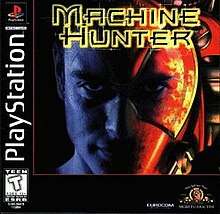Machine Hunter
| Machine Hunter | |
|---|---|
 | |
| Developer(s) | Eurocom Entertainment Software |
| Publisher(s) | MGM Interactive |
| Producer(s) | Mark Hetherington |
| Designer(s) | Rob Craven |
| Composer(s) | Neil Baldwin |
| Platform(s) | Windows, PlayStation |
| Release | August 31, 1997 |
| Genre(s) | Shoot 'em up |
| Mode(s) |
Single player Multiplayer |
Machine Hunter is a top-down shooter game developed by Eurocom Entertainment Software, published by MGM Interactive and distributed in Europe by Eidos Interactive. It was developed and released simultaneously in 1997 for Windows 95 and PlayStation console.
Gameplay
The game is presented in a top-down overhead perspective, with the option of a fixed or rotating camera. Players must guide the character through 17 unique stages whilst battling alien, mutant, and mechanical enemies. The primary focus is the rescuing of hostages and occasionally obtaining an item such as a key card, defusing or planting bombs, or completing an objective under a time limit. Players are encouraged to "transfer" or transform into one of nine unique types of robots encountered throughout the stages, each with their own distinct appearance, weapons, and abilities.[1]
Power-ups are present, scattered throughout each stage and hidden in secret areas. Power-ups include:
- Energy - Increases the player's energy by 50%.
- Power Level 2 - The player's projectiles turn green, and do more damage than the player's default weapon. Adds minor abilities to robot weaponry, such as faster fire rate or ricochet bullets
- Power Level 3 - The player's projectiles turn blue, and do even more damage than level 2. Adds major abilities to robot weaponry, such as homing projectiles or larger damage radius.
- Mines - Placed on the floor, after 5 seconds or contact with an enemy unit it will detonate, causing massive damage. If the player is too close it will damage him as well.
- Area Bomb - An area of effect detonation that heavily damages all enemy units in an approximately 10 meter radius of the player.
- Missile - A projectile fired forwards from the player and detonating on impact with an enemy or object. Does massive damage in a 10-meter radius.
- Spike Ball - A spiked ball that floats in the air, encircling the player. Kills any enemy unit with one hit, but requires being in very close proximity. There is a homing variation as well, wherein the ball will gravitate to the nearest enemy. This function has a range of about 3 meters.
- Shield - A hemispherical robotic shield that orbits the rear of the player character. Deflects projectiles if they hit, but does not deflect melee attacks or flame-based weaponry. There is an upgraded version which fires a single bullet behind the player every time the player fires his main weapons.
- Invulnerability - Very few and far between, this power-up makes the player invulnerable to all forms of damage for 25 seconds. Will not protect against falling into acid or lava pits.
Development
The title of the game changed multiple times during development. Initially announced as "H.O.S.T.", it was later renamed "Suicide Run",[1] before finally being released as Machine Hunter.
References
- 1 2 "Protos: Suicide Run". Electronic Gaming Monthly. No. 94. Ziff Davis. May 1997. p. 48.
External links
- Machine Hunter at Eurocom (via Internet Archive)
- Machine Hunter at MobyGames